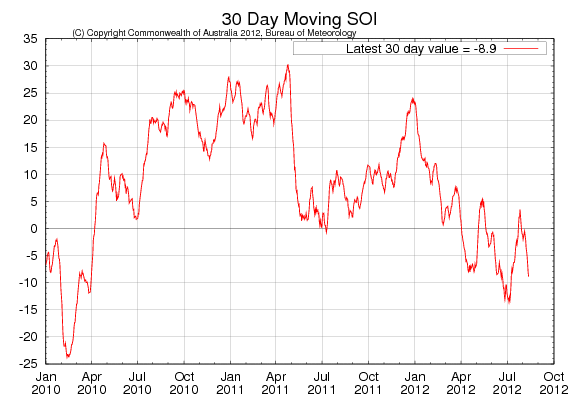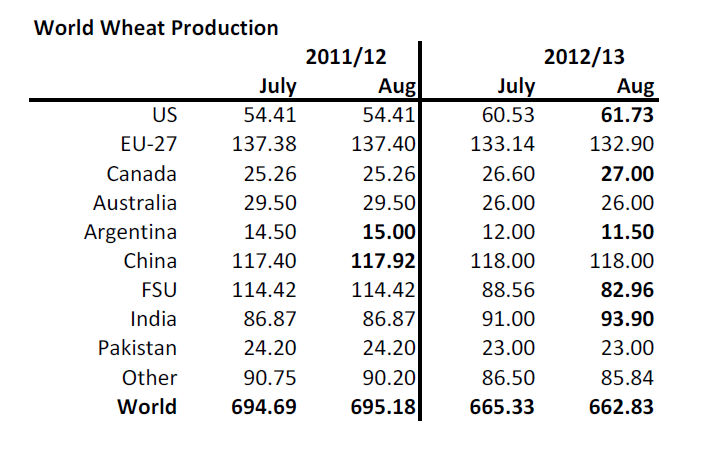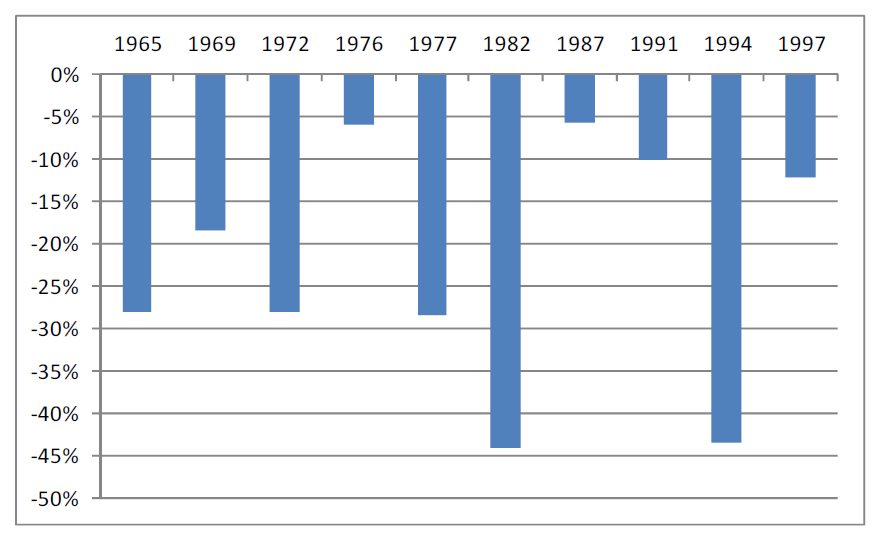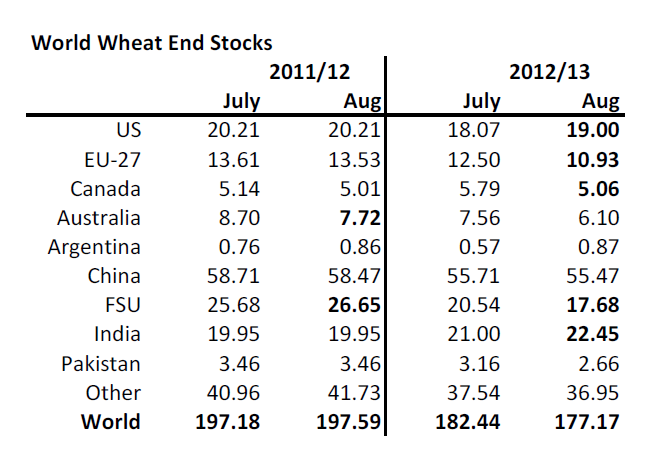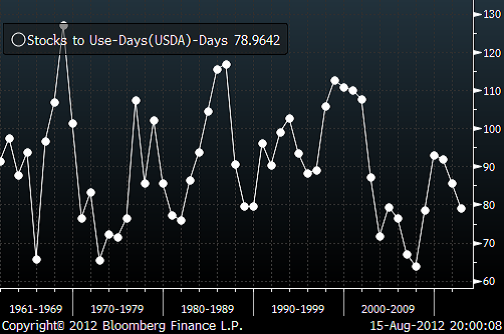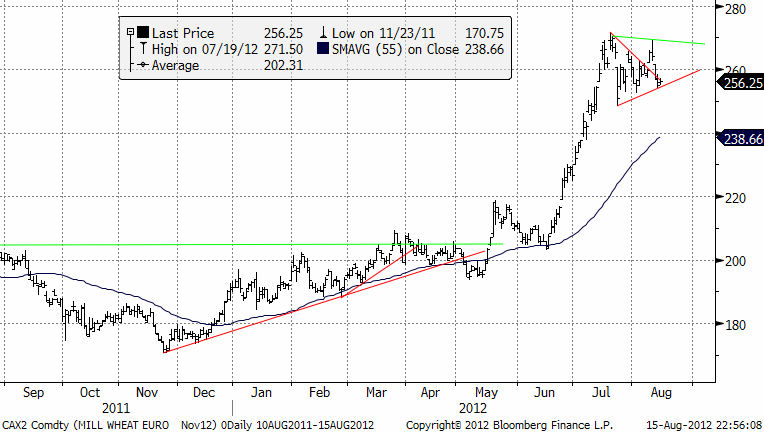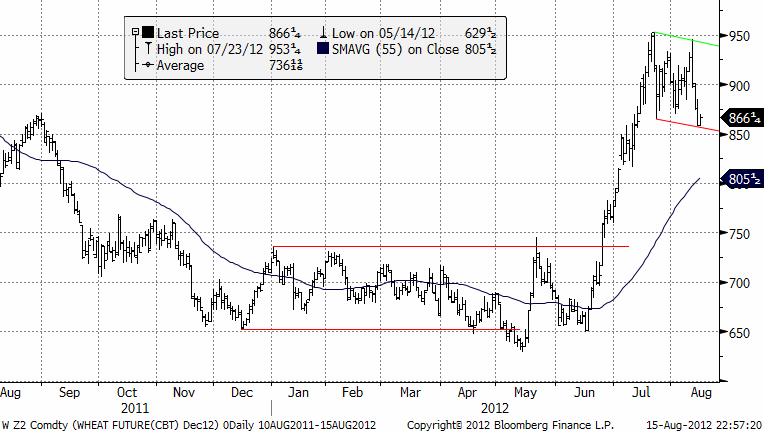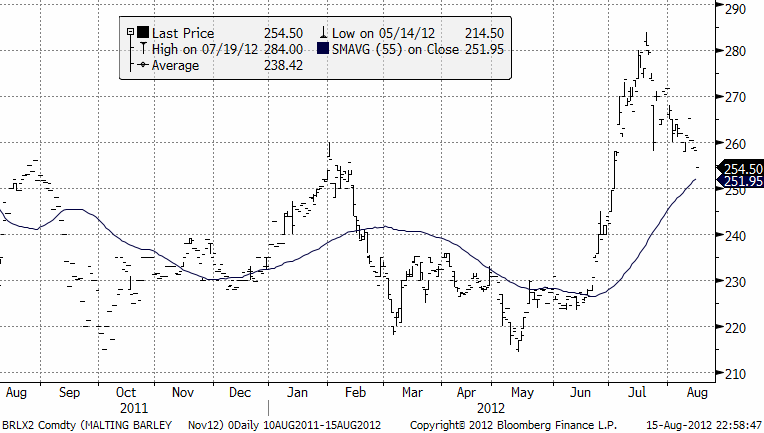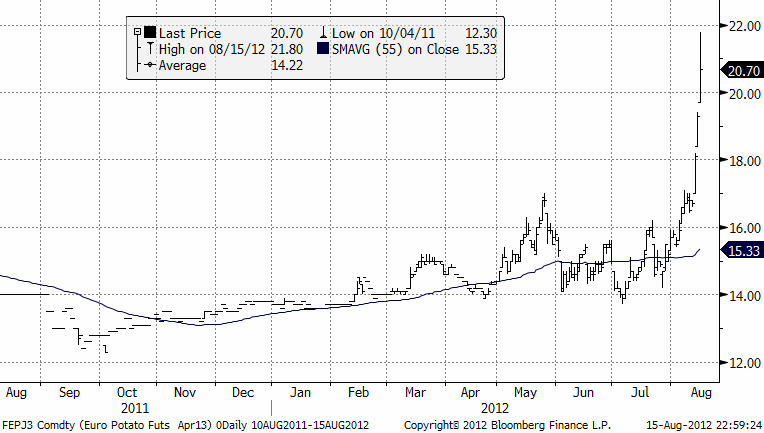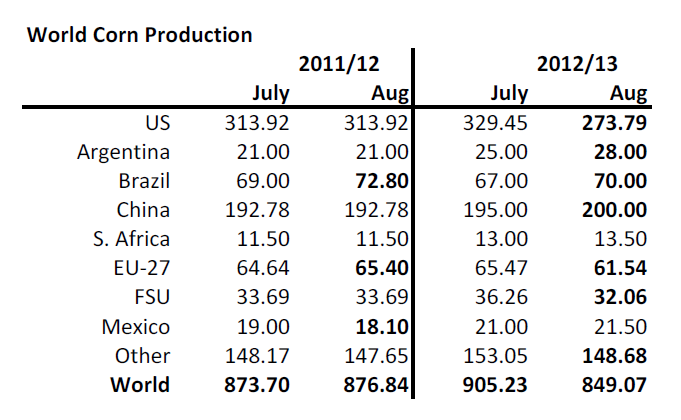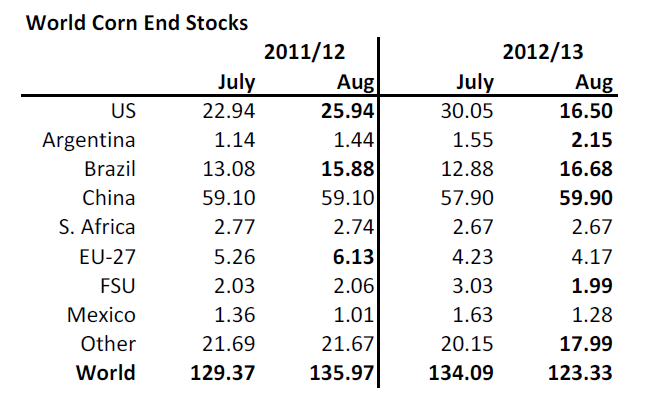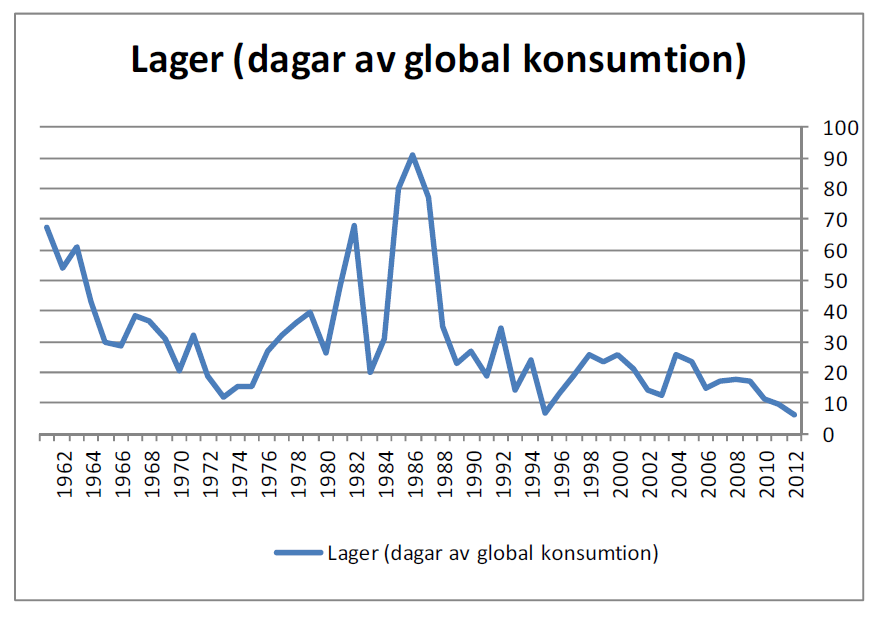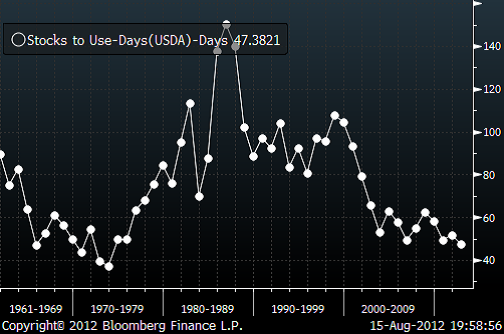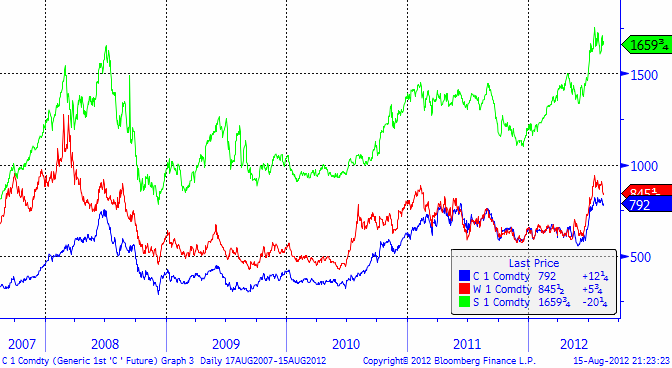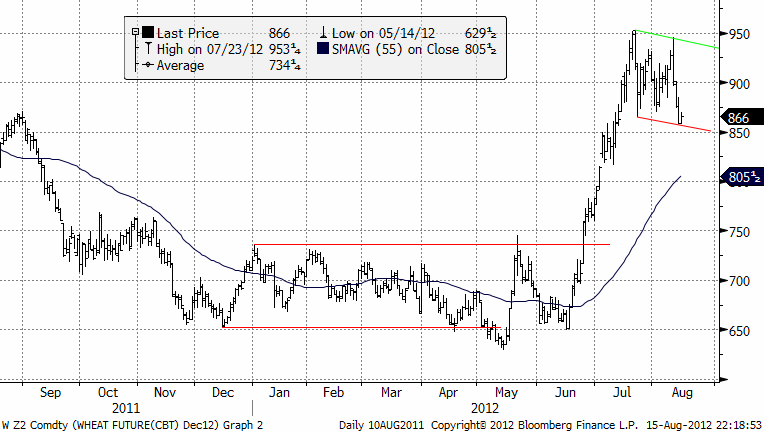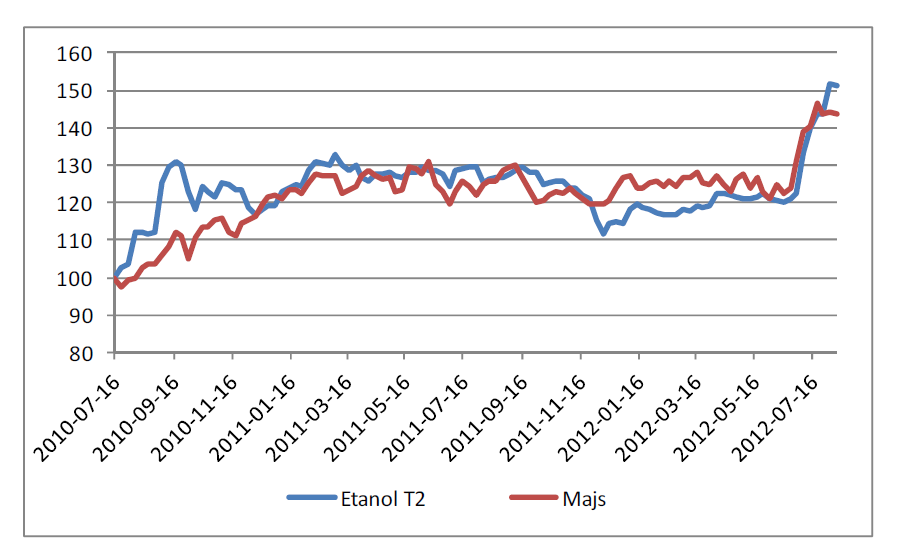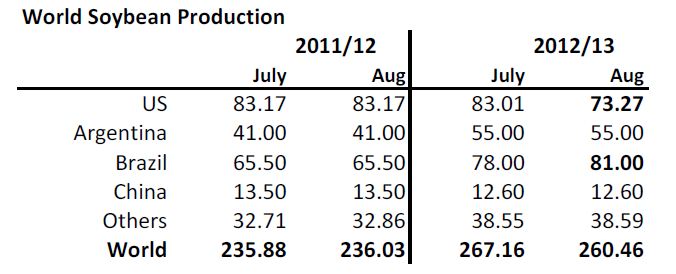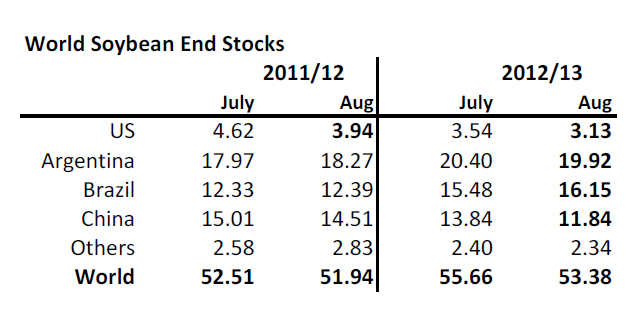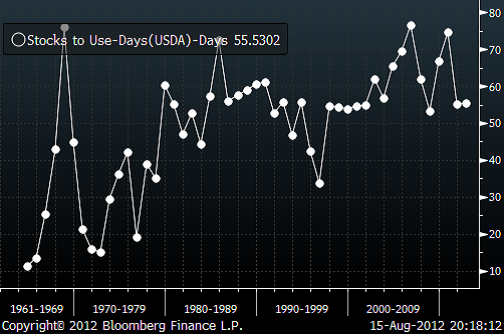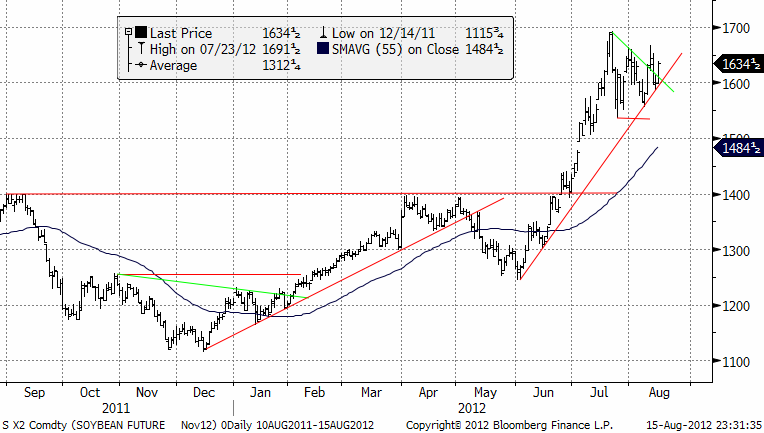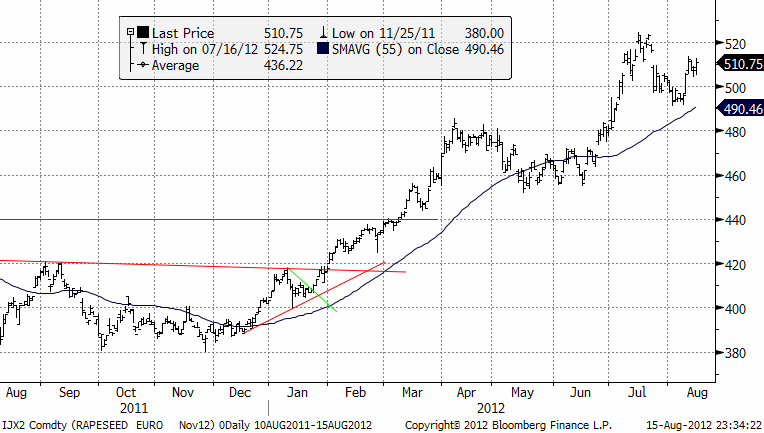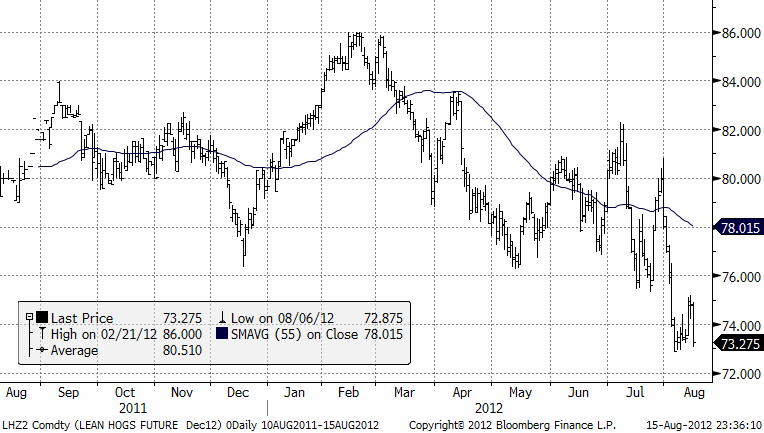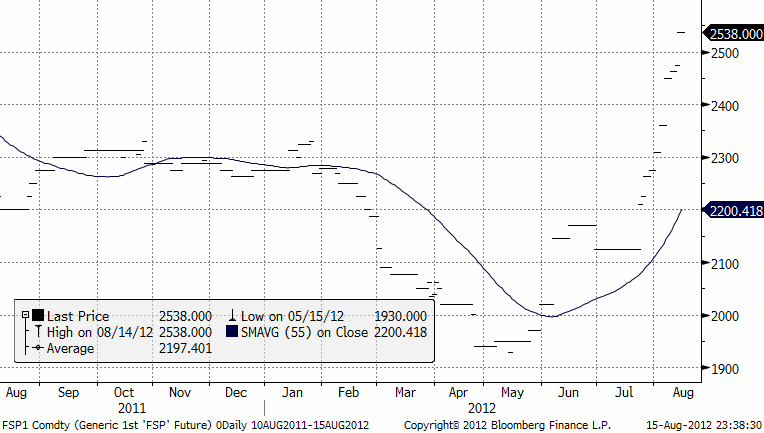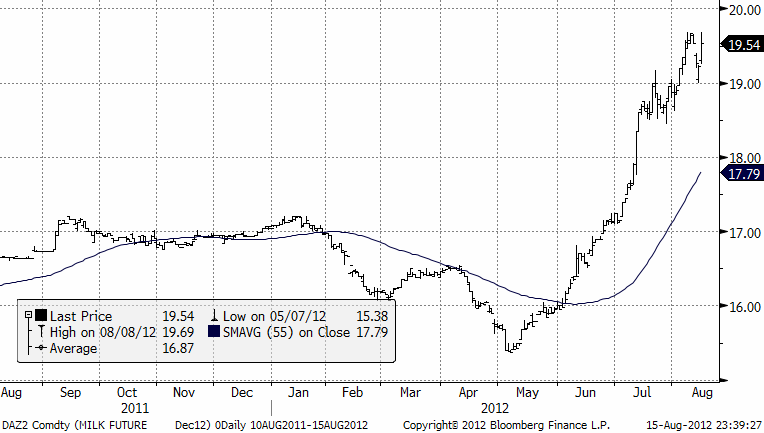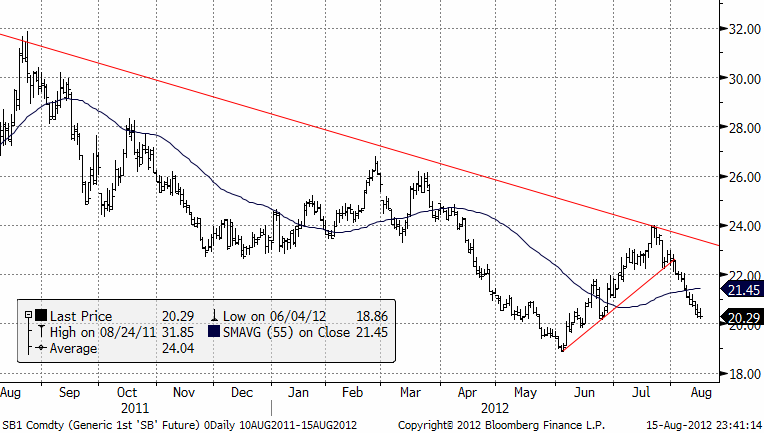Analys
SEB Jordbruksprodukter, 16 augusti 2012
 Fredagens WASDE-rapport var ”OK” för vete och sojabönor, men USDA:s prognos för utbud och efterfrågan i majs visar rekordlåga lager och vi tror inte att man tagit hänsyn till de produktionsbortfall som kunnat tas hänsyn till. Priset måste ransonera konsumtionen mycket. Risken är på uppsidan. Att priset ändå inte gick upp ordentligt beror på att EPA/USDA efter WASDE-rapporten i fredags erkände att man ”tittar på” att minska etanolanvändningen. Regn under helgen fick också sojabönspriset att mjukna.
Fredagens WASDE-rapport var ”OK” för vete och sojabönor, men USDA:s prognos för utbud och efterfrågan i majs visar rekordlåga lager och vi tror inte att man tagit hänsyn till de produktionsbortfall som kunnat tas hänsyn till. Priset måste ransonera konsumtionen mycket. Risken är på uppsidan. Att priset ändå inte gick upp ordentligt beror på att EPA/USDA efter WASDE-rapporten i fredags erkände att man ”tittar på” att minska etanolanvändningen. Regn under helgen fick också sojabönspriset att mjukna.
Ett politiskt beslut som leder till minskade stöd till etanolproduktion med majs skulle kunna få priserna att falla. Vi vet alldeles för lite än så länge om den här processen, men behåller tills vidare vår positiva vy på prisutvecklingen för majs, och därmed för vete och oljeväxter också.
Priset på potatis för ny skörd har på tre dagar stigit från 17 euro per dt till 20.70 euro. Potatishaussen är alltså det mest spännande vi har att berätta om den här veckan.
”The Duke brothers” som på 80-talet försökte klämma åt apelsinjuicemarknaden i filmen ”Ombytta roller” (Trading places), har nu fått en ny marknad. Idag är tredje dagen man kan handla frystkoncentrerad äppeljuice, på MGEX.
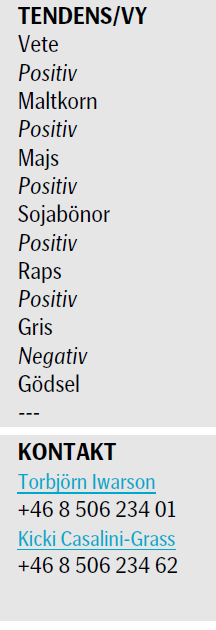 Nu har vi lagt till terminspris-tabeller för EUREX mjölkpulver och Amerikansk klass 3 flytande mjölk som handlas på CME, längst bak i det här brevet.
Nu har vi lagt till terminspris-tabeller för EUREX mjölkpulver och Amerikansk klass 3 flytande mjölk som handlas på CME, längst bak i det här brevet.
Odlingsväder
”Renewed development towards El Niño” skrev Australian Bureau of Meteorology den 14 augusti. De skriver att utvecklingen mot El Niño avtog under juli, men att utvecklingen har tagit ny fart de senaste två veckorna. Deras klimatmodeller indikerar nu att El Niño-förhållanden uppnås innan september är slut. Southern Oscillation Index (SOI) har återigen fallit och ligger nu på -8.1. Ett värde på mellan -8 och +8 indikerar neutrala ENSO-förhållanden, medan ett värde under -8 indikerar El Niño. Flera andra faktorer, såsom t ex högre temperatur vattnet i mellersta Stilla Havet pekar i samma riktning, en återkomst av El Niño. El Niño innebär generellt sett torrt och varmt väder i Australien och Sydostasien, och fuktigt väder i Sydamerika. Australien producerar mycket vete, medan Sydamerika producerar mindre vete, mindre i år än vanligt pga Kirschners konfiskatoriska skatt av argentiska veteodlare. Däremot producerar Sydamerika mycket sojabönor och mycket majs, och socker. För världen väger Sydamerikas fördelar mycket tyngre än Australiens nackdelar.
Vete
WASDE-rapporten i fredags visade precis som väntat lägre produktion. Produktionen var till och med lägre än väntat.
För USA och Kanada justerades produktionen upp något lite. Även Indien justerades upp. EU justerades ner en gnutta, liksom Argentina (på lägre areal). Ryssland justerades ner 6 mt, vilket antagligen INTE är tillräckligt, som vi skrev för ett par veckor sedan. Med 30% lägre hektarskörd, såsom siffrorna nått oss, innebär en total spannmålsskörd på 66 mt, inte 75 – 80 som Rysslands jordbruksministerium säger. Man lämnar Australiens förutspådda skörd oförändrad, förmodligen för att man inte visste något säkert om El Niño när man gjorde rapporten. Vi har sett ovan att det är mycket troligt att det kommer att vara El Niño innan slutet av september. USDA har justerat ner hektarskörden från förra året med 6% och då var förra årets hektarskörd långt över trenden. Det ligger alltså väldigt lite El Niño-effekt i siffrorna från USDA. Nedan ser vi förändringen i hektarskörd för vete i Australien från året innan, för de år då det varit El Niñoförhållanden den 30 september.
Jag har valt att identifiera El Niño med SOI < -8 per 30 september. Om vi nu tänker på att USDA endast har justerat ner förra årets hektarskörd med 6% för Australien, och vi tänker att det borde vara närmare genomsnittet de senaste 50 åren, -22%, så kan vi räkna lite. Skörden förra året i Australien var 29.5 mt. USDA har den till 26 mt i år. USDA räknar då med 6% lägre areal också. Låt oss anta att det är så och så sänker vi hektarskörden med 22% istället för 6%. Då hamnar vi på 21.5 mt. Det är alltså 4.5 mt lägre och alltså 4.5 mt lägre globala carry out stocks, eftersom detta skulle ha exporterats. Nedan ser vi USDA:s idé om carry out stocks:
Vi tror att utgående lager kommer att reduceras ytterligare. Lagren är inte akut låga i ett historiskt perspektiv. Problemet i världen är inte vete, utan majs. Nedan ser vi utgående lager enligt USDA:s prognos i förhållande till global konsumtion (i antal dagar av konsumtion).
Matifvetet med novemberleverans har fortfarande en ”bullish” triangel. Priset ”brukar” bryta upp vid sådana mönster.
Nedan ser vi Chicagovetet med leverans i december. Den tekniska bilden indikerar samma sak här, men antyder snarare att ytterligare trendlös ”sidledes” rörelse är mest sannolik.
Maltkorn
Novemberkontraktet på maltkorn ligger i en nedgångsfas som har stora likheter med vad som i efterhand ofta identifieras som en rekyl inför en ny, kraftig prisuppgång. Nedgången från förra veckan är 4 euro per ton.
Potatis
Potatispriset bröt intervallet när 17 euro bröts och det genererade en teknisk köpsignal. Säljarna klev bort från 17. Det fick priset att på tre dagar gå upp från 17 euro per dt till 21.80 som högst för att igår stänga på 20.70.
Majs
Nedanför ser vi USDA:s produktionsestimat. Sedan julirapporten har de justerat ner produktionen med 55 mt. Man har höjt produktionen med 6 mt för Brasilien + Argentina, vilket inte är orimligt om man tar hänsyn till El Niño (vilket de dock inte gjorde för veteproduktionen i Australien). Före detta Sovjetunionen har man antagligen sänkt för lite.
Nedan ser vi utgående lager. USDA har skurit bort 750 miljoner bushels i foderefterfrågan i USA. Dessutom har man sänkt åtgången till etanolproduktion med 400 mbu och 300 mbu i lägre export. Det tar ner utgående lager för USA från 30 till 16.5 mt.
I termer av USA:s konsumtion, är det den näst lägsta nivån på 50 år. 1996 var det en fraktion lägre. Ser vi dock USA som försörjaren av mat till världsmarknaden, och vi jämför utgående lager i USA med global konsumtion, så är det den lägsta lagernivån på 50 år (så långt bakåt vi har data). Vi ser ett diagram över detta nedan.
USA:s lager räcker till 6 dagar av global konsumtion. Som vi ser i diagrammet ovan ”slår” det 1995, då lagren räckte i 6.55 dagar. 1973 är ett annat lågvattenmärke. Då bottnade lagren på 12 dagar. 1973 är året för ”the Great Grain Robbery”, då Sovjetunionen råkade ut för torka och i hemlighet dammsög världsmarknaden på spannmål, innan missväxten blev känd. Det var så pass allvarligt att USDA ansåg sig behöva inrätta FAS. FAS är Foreign Agricultural Service. Det är tack vare FAS vi har så bra statistik på globalt utbud och efterfrågan som publiceras genom WASDE-rapporterna. Det lite skrämmande att inse att situationen just nu alltså är värre än 1973 när vi ser på det på det här sättet. Men det kanske inte är fullt lika illa, därför att Argentina och framförallt Brasilien har klivit in som stora producenter för världsmarknaden vid sidan av USA.
Globala utgående lager i termer av global konsumtion ser vi nedan. Det är lågt även där. Det mest väsentliga för världsmarknadspriset är emellertid inte vad som finns i t ex Kina, utan vad som kan komma ut på världsmarknaden. Störst relevans för världsmarknadspriset har situationen i USA.
Nedanför ser vi prisutvecklingen för spotkontrakten på sojabönor, vete och majs. Vi ser att världen inte egentligen har ett veteproblem, utan ett sojabönsproblem och framförallt ett majsproblem. Majs är ett mycket sämre spannmål än vete och kan inte gärna bli dyrare än vete, eftersom man då kommer att substituera majs med vete i foderblandningar. Därmed blir världens majsproblem ett veteproblem.
Måndagens crop ratings visade att majs i visade en ökning på 1% i kategorin very poor, till 26%. Förra året var det 5%. Good och Excellent var oförändrade på 20% och 3%. Priset på decembermajs har även den senaste veckan rört sig ”sidledes”, trots all ”action” i fredags vid WASDE-rapporten.
I fredags bekräftade EPA / USDA att man ”tittade på” etanolmandatet. Vi skrev för ett par veckor sedan om att Frankrike kallat in ett nytt G20-möte om matkrisen. Jag hade trott att de återigen skulle försöka anklaga ”investerare” eller ”spekulanter” för att ha drivit upp priset (i strid mot bättre vetande). Men det verkar som om fokus kommer att vara på etanolproduktion av spannmål. I en artikel i måndagens Financial Times rapporteras också om att FN vill att man på G20-mötet ska försöka begränsa produktionen av etanol med spannmål som råvara. För bara några få år sedan var det just samma FN som krävde mer etanolproduktion med spannmål.
Att majspriset hänger ihop med priset på etanol ser vi lätt i nedanstående diagram, där båda serierna börjar på 100 och anpassade med hedge-ratiot mellan etanol och majs.
Vad politikerna i USA och i G20 kommer fram till har klivit in på höstens scen som en central faktor för prisutvecklingen. Om de beslutar sig för att minska subventionerna för etanol och spara såväl pengar i sina skuldtyngda statsbudgetar, säkert lockande, och återigen ”rädda planeten”, kan de få spannmålspriset att falla kraftigt. Ironiskt nog håller EU nu på att reglera råvaruterminsmarknaden för att hindra spekulanter att orsaka volatilitet, en anklagelse som enhälligt avvisats av alla från IMF, OECD och FAO till akademia. Det är verklighetens ironi, att det nu är politikerna själva som orsakar volatiliteten på marknaden. Det är i och för sig inget ovanligt. Vi har tidigare visat hur exportstopp och prisregleringar införs av politiker när priset stiger. Genom detta får de priset på världsmarknaden att stiga ännu mer. Men hur troligt är det att Obama ett valår fattar ett politiskt beslut som ger redan bedrövade amerikanska bönder ett lägre pris på vad de nu lyckas skörda? Indiens foderindustri har begärt att exporten av majs ska förbjudas omedelbart pga den dåliga produktionen i spåren av den dåliga monsunen. Processen med exportstopp är definitivt startad nu. På en vecka har marknaden glömt frågan om Ryssland kommer att införa exportstopp. Den faktorn är trots allt alltjämt aktuell.
Priset ”borde” gå upp på den rekorddåliga skörden, men den politiska etanolfrågan vet vi för lite om än så länge. Med viss tvekan behåller vi vår köprekommendation.
Sojabönor
Väderleksprognosen för de närmaste tio dagarna innehåller en hel del regn och kallare temperaturer för relevanta sojabönsområden i USA. Men bönorna är å andra sidan ca 3 veckor tidiga i sin utveckling mot normalt. Enligt måndagens crop report sätter 83% av sojabönorna baljor nu, mot 64% förra året. Andelen i good / excellent condition ökade 1% till 30%. Produktionsestimaten i fredagens WASDE-rapport ser vi nedan.
Det är en stor sänkning för USA och en ökning för Brasilien. Enligt detta är Brasilien nu världens största producent av sojabönor. Argentina har just höjt exportskatten på biodiesel från 20% till 32%. Nedan ser vi utgående lager. USA ligger rekordlågt, liksom på majs.
Tack vare Brasilien ligger globala lager inte lågt i ett historiskt perspektiv, som vi ser i nedanstående diagram som visar utgående globala lager i termer av dagar av konsumtion. Argentina har också stora lager, men med den kortsiktiga och destruktiva jordbrukspolitik som landets president bedriver är det svårt att se hur Argentina ska kunna växa enligt sin potential.
Nedan ser vi kursdiagrammet på sojabönor med leverans i november. Sojabönor har rört sig sidledes precis som majs och vete. Om något pekar trenden fortsatt uppåt.
Raps
Priset på novemberterminen befinner sig alltjämt i en obruten uppåtgående trend. 500 som var ett starkt stöd, bröts för en vecka sedan, men köpare dök upp på 490 nivån. Trenden uppåt är intakt och det är möjligt att marknaden ska upp och testa toppen från juli igen.
Gris
Decemberkontraktet på lean hogs som bröt under stödet på 76 cent, rekylerade upp till detta (ett säljtillfälle) och har nu återtagit prisfallet.
Mjölk
Priset på mjölkpulver i Nordeuropa har fortsatt att stiga ännu en vecka. Priset har ökat 4% från 2450 euro per ton till 2538.
På den amerikanska börsen, har priset rört sig sidledes, liksom majsen och sojan. Trenden är dock uppåtriktad och 20 cent är en psykologiskt viktig ni pga att det är en så jämn siffra. Säkerligen ligger det en del ”take profit” / prissäkringsordrar där.
Socker
Priset på socker har, såsom vi har förutspått, fortsatt att sjunka. 20 cent är en psykologiskt viktig nivå. Möjligen kan det komma en rekyl på den nivån, men trenden på lite längre sikt är nedåtriktad.
[box]SEB Veckobrev Jordbruksprodukter är producerat av SEB Merchant Banking och publiceras i samarbete och med tillstånd på Råvarumarknaden.se[/box]
Disclaimer
The information in this document has been compiled by SEB Merchant Banking, a division within Skandinaviska Enskilda Banken AB (publ) (“SEB”).
Opinions contained in this report represent the bank’s present opinion only and are subject to change without notice. All information contained in this report has been compiled in good faith from sources believed to be reliable. However, no representation or warranty, expressed or implied, is made with respect to the completeness or accuracy of its contents and the information is not to be relied upon as authoritative. Anyone considering taking actions based upon the content of this document is urged to base his or her investment decisions upon such investigations as he or she deems necessary. This document is being provided as information only, and no specific actions are being solicited as a result of it; to the extent permitted by law, no liability whatsoever is accepted for any direct or consequential loss arising from use of this document or its contents.
About SEB
SEB is a public company incorporated in Stockholm, Sweden, with limited liability. It is a participant at major Nordic and other European Regulated Markets and Multilateral Trading Facilities (as well as some non-European equivalent markets) for trading in financial instruments, such as markets operated by NASDAQ OMX, NYSE Euronext, London Stock Exchange, Deutsche Börse, Swiss Exchanges, Turquoise and Chi-X. SEB is authorized and regulated by Finansinspektionen in Sweden; it is authorized and subject to limited regulation by the Financial Services Authority for the conduct of designated investment business in the UK, and is subject to the provisions of relevant regulators in all other jurisdictions where SEB conducts operations. SEB Merchant Banking. All rights reserved.
Analys
Crude oil soon coming to a port near you

Rebounding along with most markets. But concerns over solidity of Gaza peace may also contribute. Brent crude fell 0.8% yesterday to $61.91/b and its lowest close since May this year. This morning it is bouncing up 0.9% to $62.5/b along with a softer USD amid positive sentiment with both equities and industrial metals moving higher. Concerns that the peace in Gaza may be less solid than what one might hope for also yields some support to Brent. Bets on tech stocks are rebounding, defying fears of trade war. Money moving back into markets. Gold continues upwards its strong trend and a softer dollar helps it higher today as well.

US crude & products probably rose 5.6 mb last week (API) versus a normal seasonal decline of 2.4 mb. The US API last night partial and thus indicative data for US oil inventories. Their data indicates that US crude stocks rose 7.4 mb last week, gasoline stocks rose 3.0 mb while Distillate stocks fell 4.8 mb. Altogether an increase in commercial crude and product stocks of 5.6 mb. Commercial US crude and product stocks normally decline by 2.4 mb this time of year. So seasonally adjusted the US inventories rose 8 mb last week according to the indicative numbers by the API. That is a lot. Also, the counter seasonal trend of rising stocks versus normally declining stocks this time of year looks on a solid pace of continuation. If the API is correct then total US crude and product stocks would stand 41 mb higher than one year ago and 6 mb higher than the 2015-19 average. And if we combine this with our knowledge of a sharp increase in production and exports by OPEC(+) and a large increase in oil at sea, then the current trend in US oil inventories looks set to continue. So higher stocks and lower crude oil prices until OPEC(+) switch to cuts. Actual US oil inventory data today at 18:00 CET.
US commercial crude and product stocks rising to 1293 mb in week 41 if last nights indicative numbers from API are correct.

Crude oil soon coming to a port near you. OPEC has lifted production sharply higher this autumn. At the same time demand for oil in the Middle-East has fallen as we have moved out of summer heat and crude oil burn for power for air-conditioning. The Middle-East oil producers have thus been able to lift exports higher on both accounts. Crude oil and condensates on water has shot up by 177 mb since mid-August. This oil is now on its way to ports around the world. And when they arrive, it will likely help to lift stocks onshore higher. That is probably when we will lose the last bit of front-end backwardation the the crude oil curves. That will help to drive the front-month Brent crude oil price down to the $60/b line and revisit the high $50ies/b. Then the eyes will be all back on OPEC+ when they meet in early November and then again in early December.
Crude oil and condensates at sea have moved straight up by 177 mb since mid-August as OPEC(+) has produced more, consumed less and exported more.

Analys
The Mid-East anchor dragging crude oil lower

When it starts to move lower it moves rather quickly. Gaza, China, IEA. Brent crude is down 2.1% today to $62/b after having traded as high as $66.58/b last Thursday and above $70/b in late September. The sell-off follows the truce/peace in Gaze, a flareup in US-China trade and yet another bearish oil outlook from the IEA.

A lasting peace in Gaze could drive crude oil at sea to onshore stocks. A lasting peace in Gaza would probably calm down the Houthis and thus allow more normal shipments of crude oil to sail through the Suez Canal, the Red Sea and out through the Bab-el-Mandeb Strait. Crude oil at sea has risen from 48 mb in April to now 91 mb versus a pre-Covid normal of about 50-60 mb. The rise to 91 mb is probably the result of crude sailing around Africa to be shot to pieces by the Houthis. If sailings were to normalize through the Suez Canal, then it could free up some 40 mb in transit at sea moving onshore into stocks.
The US-China trade conflict is of course bearish for demand if it continues.
Bearish IEA yet again. Getting closer to 2026. Credibility rises. We expect OPEC to cut end of 2025. The bearish monthly report from the IEA is what it is, but the closer we get to 2026, the more likely the IEA is of being ball-park right in its outlook. In its monthly report today the IEA estimates that the need for crude oil from OPEC in 2026 will be 25.4 mb/d versus production by the group in September of 29.1 mb/d. The group thus needs to do some serious cutting at the end of 2025 if it wants to keep the market balanced and avoid inventories from skyrocketing. Given that IEA is correct that is. We do however expect OPEC to implement cuts to avoid a large increase in inventories in Q1-26. The group will probably revert to cuts either at its early December meeting when they discuss production for January or in early January when they discuss production for February. The oil price will likely head yet lower until the group reverts to cuts.
Dubai: The Mid-East anchor dragging crude oil lower. Surplus emerging in Mid-East pricing. Crude oil prices held surprisingly strong all through the summer. A sign and a key source of that strength came from the strength in the front-end backwardation of the Dubai crude oil curve. It held out strong from mid-June and all until late September with an average 1-3mth time-spread premium of $1.8/b from mid-June to end of September. The 1-3mth time-spreads for Brent and WTI however were in steady deterioration from late June while their flat prices probably were held up by the strength coming from the Persian Gulf. Then in late September the strength in the Dubai curve suddenly collapsed. Since the start of October it has been weaker than both the Brent and the WTI curves. The Dubai 1-3mth time-spread now only stands at $0.25/b. The Middle East is now exporting more as it is producing more and also consuming less following elevated summer crude burn for power (Aircon) etc.
The only bear-element missing is a sudden and solid rise in OECD stocks. The only thing that is missing for the bear-case everyone have been waiting for is a solid, visible rise in OECD stocks in general and US oil stocks specifically. So watch out for US API indications tomorrow and official US oil inventories on Thursday.
No sign of any kind of fire-sale of oil from Saudi Arabia yet. To what we can see, Saudi Arabia is not at all struggling to sell its oil. It only lowered its Official Selling Prices (OSPs) to Asia marginally for November. A surplus market + Saudi determination to sell its oil to the market would normally lead to a sharp lowering of Saudi OSPs to Asia. Not yet at least and not for November.
The 5yr contract close to fixed at $68/b. Of importance with respect to how far down oil can/will go. When the oil market moves into a surplus then the spot price starts to trade in a large discount to the 5yr contract. Typically $10-15/b below the 5yr contract on average in bear-years (2009, 2015, 2016, 2020). But the 5yr contract is usually pulled lower as well thus making this approach a moving target. But the 5yr contract price has now been rock solidly been pegged to $68/b since 2022. And in the 2022 bull-year (Brent spot average $99/b), the 5yr contract only went to $72/b on average. If we assume that the same goes for the downside and that 2026 is a bear-year then the 5yr goes to $64/b while the spot is trading at a $10-15/b discount to that. That would imply an average spot price next year of $49-54/b. But that is if OPEC doesn’t revert to cuts and instead keeps production flowing. We think OPEC(+) will trim/cut production as needed into 2026 to prevent a huge build-up in global oil stocks and a crash in prices. But for now we are still heading lower. Into the $50ies/b.
Analys
More weakness and lower price levels ahead, but the world won’t drown in oil in 2026

Some rebound but not much. Brent crude rebounded 1.5% yesterday to $65.47/b. This morning it is inching 0.2% up to $65.6/b. The lowest close last week was on Thursday at $64.11/b.

The curve structure is almost as week as it was before the weekend. The rebound we now have gotten post the message from OPEC+ over the weekend is to a large degree a rebound along the curve rather than much strengthening at the front-end of the curve. That part of the curve structure is almost as weak as it was last Thursday.
We are still on a weakening path. The message from OPEC+ over the weekend was we are still on a weakening path with rising supply from the group. It is just not as rapidly weakening as was feared ahead of the weekend when a quota hike of 500 kb/d/mth for November was discussed.
The Brent curve is on its way to full contango with Brent dipping into the $50ies/b. Thus the ongoing weakening we have had in the crude curve since the start of the year, and especially since early June, will continue until the Brent crude oil forward curve is in full contango along with visibly rising US and OECD oil inventories. The front-month Brent contract will then flip down towards the $60/b-line and below into the $50ies/b.
At what point will OPEC+ turn to cuts? The big question then becomes: When will OPEC+ turn around to make some cuts? At what (price) point will they choose to stabilize the market? Because for sure they will. Higher oil inventories, some more shedding of drilling rigs in US shale and Brent into the 50ies somewhere is probably where the group will step in.
There is nothing we have seen from the group so far which indicates that they will close their eyes, let the world drown in oil and the oil price crash to $40/b or below.
The message from OPEC+ is also about balance and stability. The world won’t drown in oil in 2026. The message from the group as far as we manage to interpret it is twofold: 1) Taking back market share which requires a lower price for non-OPEC+ to back off a bit, and 2) Oil market stability and balance. It is not just about 1. Thus fretting about how we are all going to drown in oil in 2026 is totally off the mark by just focusing on point 1.
When to buy cal 2026? Before Christmas when Brent hits $55/b and before OPEC+ holds its last meeting of the year which is likely to be in early December.
Brent crude oil prices have rebounded a bit along the forward curve. Not much strengthening in the structure of the curve. The front-end backwardation is not much stronger today than on its weakest level so far this year which was on Thursday last week.

The front-end backwardation fell to its weakest level so far this year on Thursday last week. A slight pickup yesterday and today, but still very close to the weakest year to date. More oil from OPEC+ in the coming months and softer demand and rising inventories. We are heading for yet softer levels.

-

 Nyheter3 veckor sedan
Nyheter3 veckor sedanOPEC+ missar produktionsmål, stöder oljepriserna
-

 Nyheter4 veckor sedan
Nyheter4 veckor sedanEtt samtal om guld, olja, fjärrvärme och förnybar energi
-

 Nyheter2 veckor sedan
Nyheter2 veckor sedanGoldman Sachs höjer prognosen för guld, tror priset når 4900 USD
-

 Nyheter2 veckor sedan
Nyheter2 veckor sedanGuld nära 4000 USD och silver 50 USD, därför kan de fortsätta stiga
-

 Analys4 veckor sedan
Analys4 veckor sedanAre Ukraine’s attacks on Russian energy infrastructure working?
-

 Nyheter3 veckor sedan
Nyheter3 veckor sedanBlykalla och amerikanska Oklo inleder ett samarbete
-

 Nyheter4 veckor sedan
Nyheter4 veckor sedanGuldpriset uppe på nya höjder, nu 3750 USD
-

 Nyheter3 veckor sedan
Nyheter3 veckor sedanEtt samtal om guld, olja, koppar och stål


